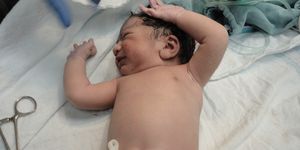Revealing More About the Genetics of Ewing Sarcoma
Ewing sarcoma is a rare kind of cancer that tends to impact young people and occurs in bones or the tissue around them. It may begin in the pelvis but could start in any bone. Ewing sarcoma often begins when a piece of DNA is rearranged, like when a gene called EWSR1, which sits on chromosome 22, fuses with a gene on chromosome 11 called FLI1. A fusion protein is then created by cells where this chromosomal translocation has taken place, and the EWSR1-FLI1 protein can promote the development of tumors. The EWSR1 portion can activate transcription, while FLI1 enables it to bind to DNA.
In new work reported in Science Advances, researchers have identified a crucial role for a gene called RING1B in the development of Ewing sarcoma. The EWSR1-FLI1 fusion protein is oncogenic, hijacking transcription, in which genes are turned into RNA so they can be translated into proteins. Cells carrying this fusion protein become cancerous as they start to divide uncontrollably.
Both RING1B and EWSR1-FLI1 go to the same part of the genome, and RING1B recruits the fusion protein to the DNA. The researchers determined that when RING1B is depleted, tumor growth is impaired in cells with the fusion protein. Without RING1B, the EWSR1-FLI1 fusion protein is not able to turn its target genes on and turn a healthy cell into a cancerous one.
"Our findings offer striking insights into the mechanism of Ewing sarcoma, helping us get closer to uncovering the elusive cell-of-origin for this rare type of cancer," said study co-author Luciano Di Croce, a researcher at the Centre for Genomic Regulation (CRG). "All we have to do is look for high levels of RING1B."
While scientists have proposed using epigenetic inhibitors, which can affect gene activity, for the treatment of Ewing sarcoma, this work indicates that inhibiting RING1B could also be a way to treat this cancer.
"EWSR1-FLI1 remains a challenging druggable target, therefore understanding its dependencies may offer alternative strategies to switch off its aberrant transcriptional program," said the first study author Sara Sánchez-Molina, a postdoctoral researcher at the Institut de Recerca Sant Joan de Déu.
"Ewing tumors are paradigmatic examples of developmental cancers, where the first hit (genetic or epigenetic) occurs during embryonic development and, in the majority of Ewing sarcomas, develops postnatally during specific stages of growth like puberty. The study supports the model by which embryonic stem cells characterized by high levels of RING1B are capable to sustain the aberrant transcriptional program caused by the oncogenic fusion protein. Ewing sarcoma will develop if the individual is born with precursor cells bearing the fusion oncoprotein," added study director Jaume Mora, Scientific Director of the Pediatric Cancer Center Barcelona-Institut de Recerca Sant Joan de Déu.
Sources: AAAS/Eurekalert! via Center for Genomic Regulation, Science Advances









